Setting the Table - Rules and Etiquette
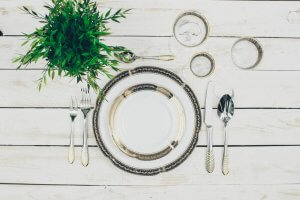
The strict rules of table etiquette that govern formal dinners can be a little intimidating. You constantly worry that you’ll forget something and embarrass yourself. There are so many different utensils to remember and so many rules. To help you get to grips with all this, we want to tell you all about setting the table.
One easy way to learn more about the rules and etiquette expected at a formal dinner is to learn how to set the table correctly. Setting up a dinner table for a formal occasion isn’t something we all know how to do automatically.
Once you know how to do it, you’ll find formal dinners a far more relaxing and enjoyable experience. Today, we want to set you a mini-challenge – try putting these simple rules into practice at home over the next few days. After all, practice makes perfect. Plus, we all sit down to eat several times a day, so there is no excuse. Let’s get started!
The art of setting the table
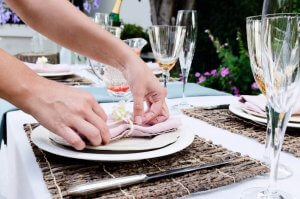
Whether brunch with friends, lunch with coworkers, or a special dinner with the whole family, if you want to create something spectacular, you can’t just stop at the food.
Complete mastery of every aspect of table etiquette is an art form that will allow you to socialize more easily. It’s a social skill that’s worth developing. Today, we’ll take a look at some of the most important aspects to keep in mind.
General rules for setting the table
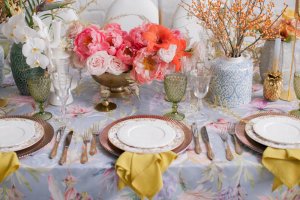
Let’s start with the easy stuff. There are some basic things you should always do if you want to set the table properly. A complete table set consists of tableware, a full set of cutlery and glassware.
The first thing you need to do is cover the table with a cloth. This is where you can start to create a real work of art. Regardless of the type of tablecloth you’re going to use, every table should have a protective cover to prevent any marks or scratches, and make it more comfortable for guests to use.
Traditionally, people would generally use white or light-colored table cloths for very formal occasions. But times have changed, and today you can use pretty much any color you like. The important thing is that it should be spotlessly clean and perfectly ironed. This is essential. A wrinkled or stained tablecloth will spoil the whole look.
Cutlery
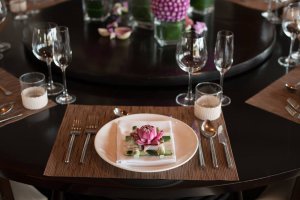
For many people, using the right utensils is often the most daunting part of table etiquette. For starters, the fork always goes to the left of the plate, with the knife and spoon to the right. When it comes to arranging the cutlery, the general rule of thumb is that they should always be placed in reverse order of use. This means that the cutlery you’re going to use first should be placed furthest from the plate.
Knives are always placed with the serrated edge facing toward the plate. Each item of cutlery should be equally spaced out.
A basic cutlery set consists of a spoon, a fork, a knife, and dessert cutlery. The latter are always placed above the plate, on the side furthest from the diner. Depending on the occasion, you may also need some extra items of cutlery.
These extras are usually utensils for seafood or fish, or teaspoons for ice cream or sorbet. If, as a diner, you have any doubts about what each piece of cutlery is for, you simply need to remember to use them in the order in which they serve the dishes. Of course, in rare cases, you may come across some fancier pieces of cutlery. If you’re not sure what to do with them, try copying the people around you.
Glasses
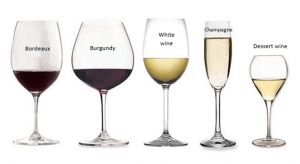
The position of the knife also tells you where to place the glasses. Water glasses should be placed in line with the knife, while the rest should be lined up from largest to smallest to the right of the water glass. Glassware sets can vary greatly, but this simple guide should work for most formal table settings.
You should always provide at least two glasses, one for water and one for wine. If there are more than two kinds of wine on offer, you should provide one glass for each type of wine – one for white and one for red. The red wine glass should be placed right next to the water glass. If it’s a formal occasion, you may want to provide several other types of glasses as well.
Plates
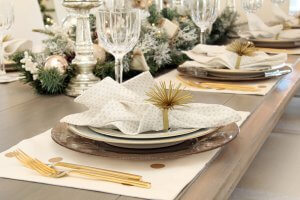
Start by placing a dinner plate in the center of the setting. There should always be a dinner plate and a soup bowl, even if your guests will only be using the soup bowl. You should never place the soup bowl directly onto the table. If you’re serving soup and a salad, place the salad plate on top of the dinner plate, and the soup bowl on top of the salad plate. It’s important to make sure you have a complete set of dinnerware.
Plates should be placed 18 inches apart and roughly an inch from the edge of the table. The bread plate should be placed in the upper left corner, to which you can also add a small butter knife.
Food is normally served from the left-hand side unless it arrives on the plate. In this case, it can be served from either side. Empty plates are removed from the right. When pouring drinks, the bottle should never touch the glass. Nor should you ever raise your glass while you’re being served. Sometimes it can be tempting to raise your glass in an attempt to make things easier, but it can make things more difficult.
Napkins

Not even experts in table etiquette can agree on where you should place your napkin. However, what we do know is where not to put it.
You should never place napkins inside the glasses, or between the glass and the plate. You can, however, place your napkin to the left or right of the plate, or on the plate itself. The good thing about placing it on the right is that most people are right-handed, and so are more likely to pick up their napkin with their right rather than their left.
You must be careful not to leave lipstick stains on your napkin. It’s best to remove any lip make up before sitting down to dinner. The napkin should be unfolded and placed on your lap during the meal. Once you’re done eating, you can leave it unfolded to the right of your plate.
Table etiquette: the basics

Whether a formal dinner or a casual lunch with friends, there are some things you should do while sitting at the table, and some things you should never do. For example, whenever you take a drink from your glass, you should wipe your mouth with your napkin.
If the soup is hot, you should never blow on it or slurp it. Instead, the polite thing to do is to simply wait for it to cool. And, most important of all, you should never tip the bowl to finish the last few mouthfuls of soup.
In the US, both hands should be used to cut your food, before placing your left hand in your lap, under the table. In other countries, however, your hands should be kept in sight at all times, without putting your elbows on the table.
If you want to take a break from eating, but you’re not completely done with your food, you need to place both pieces of cutlery side by side on the plate (without touching one another). The fork should be placed face up, while the knife should be placed so that its serrated edge is on the side closest to the fork.
If you want to let your host know that you loved the food, you can place your knife and fork horizontally across the plate. The knife should be closest to you, with the serrated edge pointing toward the fork.
Table decorations

This is where you can start getting a bit more creative. However, some people tend to go overboard, making the table too cluttered and difficult to navigate. When it comes to decorating for a formal meal, all you’ll need is a simple centerpiece or some flowers. Candles are only really useful if your event is taking place at night. Don’t forget that background music is one of the best ways to set the right tone for your dinner party.
The strict rules of table etiquette that govern formal dinners can be a little intimidating. You constantly worry that you’ll forget something and embarrass yourself. There are so many different utensils to remember and so many rules. To help you get to grips with all this, we want to tell you all about setting the table.
One easy way to learn more about the rules and etiquette expected at a formal dinner is to learn how to set the table correctly. Setting up a dinner table for a formal occasion isn’t something we all know how to do automatically.
Once you know how to do it, you’ll find formal dinners a far more relaxing and enjoyable experience. Today, we want to set you a mini-challenge – try putting these simple rules into practice at home over the next few days. After all, practice makes perfect. Plus, we all sit down to eat several times a day, so there is no excuse. Let’s get started!
The art of setting the table

Whether brunch with friends, lunch with coworkers, or a special dinner with the whole family, if you want to create something spectacular, you can’t just stop at the food.
Complete mastery of every aspect of table etiquette is an art form that will allow you to socialize more easily. It’s a social skill that’s worth developing. Today, we’ll take a look at some of the most important aspects to keep in mind.
General rules for setting the table

Let’s start with the easy stuff. There are some basic things you should always do if you want to set the table properly. A complete table set consists of tableware, a full set of cutlery and glassware.
The first thing you need to do is cover the table with a cloth. This is where you can start to create a real work of art. Regardless of the type of tablecloth you’re going to use, every table should have a protective cover to prevent any marks or scratches, and make it more comfortable for guests to use.
Traditionally, people would generally use white or light-colored table cloths for very formal occasions. But times have changed, and today you can use pretty much any color you like. The important thing is that it should be spotlessly clean and perfectly ironed. This is essential. A wrinkled or stained tablecloth will spoil the whole look.
Cutlery

For many people, using the right utensils is often the most daunting part of table etiquette. For starters, the fork always goes to the left of the plate, with the knife and spoon to the right. When it comes to arranging the cutlery, the general rule of thumb is that they should always be placed in reverse order of use. This means that the cutlery you’re going to use first should be placed furthest from the plate.
Knives are always placed with the serrated edge facing toward the plate. Each item of cutlery should be equally spaced out.
A basic cutlery set consists of a spoon, a fork, a knife, and dessert cutlery. The latter are always placed above the plate, on the side furthest from the diner. Depending on the occasion, you may also need some extra items of cutlery.
These extras are usually utensils for seafood or fish, or teaspoons for ice cream or sorbet. If, as a diner, you have any doubts about what each piece of cutlery is for, you simply need to remember to use them in the order in which they serve the dishes. Of course, in rare cases, you may come across some fancier pieces of cutlery. If you’re not sure what to do with them, try copying the people around you.
Glasses

The position of the knife also tells you where to place the glasses. Water glasses should be placed in line with the knife, while the rest should be lined up from largest to smallest to the right of the water glass. Glassware sets can vary greatly, but this simple guide should work for most formal table settings.
You should always provide at least two glasses, one for water and one for wine. If there are more than two kinds of wine on offer, you should provide one glass for each type of wine – one for white and one for red. The red wine glass should be placed right next to the water glass. If it’s a formal occasion, you may want to provide several other types of glasses as well.
Plates

Start by placing a dinner plate in the center of the setting. There should always be a dinner plate and a soup bowl, even if your guests will only be using the soup bowl. You should never place the soup bowl directly onto the table. If you’re serving soup and a salad, place the salad plate on top of the dinner plate, and the soup bowl on top of the salad plate. It’s important to make sure you have a complete set of dinnerware.
Plates should be placed 18 inches apart and roughly an inch from the edge of the table. The bread plate should be placed in the upper left corner, to which you can also add a small butter knife.
Food is normally served from the left-hand side unless it arrives on the plate. In this case, it can be served from either side. Empty plates are removed from the right. When pouring drinks, the bottle should never touch the glass. Nor should you ever raise your glass while you’re being served. Sometimes it can be tempting to raise your glass in an attempt to make things easier, but it can make things more difficult.
Napkins

Not even experts in table etiquette can agree on where you should place your napkin. However, what we do know is where not to put it.
You should never place napkins inside the glasses, or between the glass and the plate. You can, however, place your napkin to the left or right of the plate, or on the plate itself. The good thing about placing it on the right is that most people are right-handed, and so are more likely to pick up their napkin with their right rather than their left.
You must be careful not to leave lipstick stains on your napkin. It’s best to remove any lip make up before sitting down to dinner. The napkin should be unfolded and placed on your lap during the meal. Once you’re done eating, you can leave it unfolded to the right of your plate.
Table etiquette: the basics

Whether a formal dinner or a casual lunch with friends, there are some things you should do while sitting at the table, and some things you should never do. For example, whenever you take a drink from your glass, you should wipe your mouth with your napkin.
If the soup is hot, you should never blow on it or slurp it. Instead, the polite thing to do is to simply wait for it to cool. And, most important of all, you should never tip the bowl to finish the last few mouthfuls of soup.
In the US, both hands should be used to cut your food, before placing your left hand in your lap, under the table. In other countries, however, your hands should be kept in sight at all times, without putting your elbows on the table.
If you want to take a break from eating, but you’re not completely done with your food, you need to place both pieces of cutlery side by side on the plate (without touching one another). The fork should be placed face up, while the knife should be placed so that its serrated edge is on the side closest to the fork.
If you want to let your host know that you loved the food, you can place your knife and fork horizontally across the plate. The knife should be closest to you, with the serrated edge pointing toward the fork.
Table decorations

This is where you can start getting a bit more creative. However, some people tend to go overboard, making the table too cluttered and difficult to navigate. When it comes to decorating for a formal meal, all you’ll need is a simple centerpiece or some flowers. Candles are only really useful if your event is taking place at night. Don’t forget that background music is one of the best ways to set the right tone for your dinner party.







